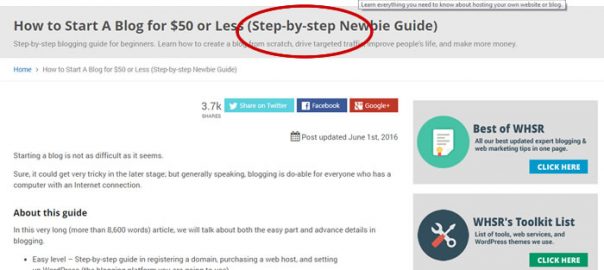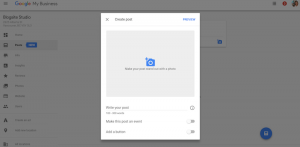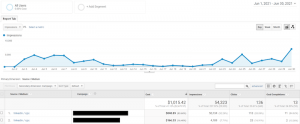James Reynolds recetnly wrote 16 SEO experiments that will change the way you think about SEO and challenged some popular misconceptions in SEO with science. Inspired by James Reynold’s work, I wrote this last week. And based on those studies and experiments, I will dig a little bit deeper and suggest some actionable SEO tips in today’s article. I hope you will see some fast results with these helps.
Let’s dive right in.
Improve CTR for Better Search Ranking
In my previous article, I talked about the misconception that click thru rate (CTR) doesn’t have an impact on search rankings. Rand Fishkin from Moz ran an experiment that blew that right out of the water. He quickly determined that your CTR has a big impact on your search ranking, so if you want your site to rank well, you need to boost your CTR.
Fortunately, you have a lot of control over your CTR. Let’s look at some ways you can improve your CTR.
Page Title
If you want to improve your CTR, you need to start with your page title. In fact, your page title is the most important factor when it comes to your CTR. Think of your title as a two-second advertisement on Google; it has to inform and hook someone to click on your site.
Writing page titles that get clicked
Here are some writing tricks that you can make use of right away:
1. Start by adding a date (year) to the page title whenever it’s appropriate.
That will make your page more relevant to the searchers, which will increase the CTR. For instance, “Most Popular TV Shows of 2016” is usually more clickable than “Most Popular TV Shows.”
2. Add in the viral factors.
The majority of content that goes viral, according to Buzzfeed, are one of these seven types of content: LOL (humorous), Win (useful), OMG (shocking), Cute (adorable), Trashy (ridiculous), Fail (something everyone shared the frustration of), and WTF (strange). Consider adding some of these elements into your page titles to attract more clicks.
Here’s one real life example.
3. Promote the benefits in your page title.
You also have to make sure that you sell the benefit instead of the features in the headline. For instance, if you’re selling an MP3 player, don’t say that it has 16 GB of storage. Instead, tell the readers that it stores 1,000 songs. That is much more powerful in the headline. You want the readers to know how it benefits them so they will click to learn more.
4. A/B test your page title
Once you come up with a great title, it’s time to test it out. Head over to AdWords and run an A/B test. You’ll need to create a second variation of the title and then run a campaign to see which headline performs better. You can also use Facebook ads and run a second A/B test. Facebook is a great option because it has additional targeting choices.
You might wonder how this type of A/B testing will help your campaign, but I have actually used the information I’ve gathered from ad campaigns for my titles.
For example, one time I ran a Facebook campaign that included the phrase “step-by-step” in the title. It received more clicks than any of my other ads. I put that phrase in my page title and improved the page’s CTR. This is proof that this strategy works.

There is a solid reason why I am using the phrase “step-by-step” in my page title (see it live here).

I have proved repeatedly, in some countries, the phrase “step-by-step” will draw more clicks and better CTR results no matter what.
Include Schema Markup in Your Site
If you’re serious about improving your CTR, you need to include schema markup on every page of your website.
Schema markup is underutilized, so if you include it on your site, you’ll be ahead of a lot of your competitors. Once you have this on your site, your site will provide search engines with information, and the search engines will be able to return information to users. Schema markup doesn’t just tell search engines what the information says. It tells them what the information means, which helps search engines know what information to return to users. When search engines provide people with relevant information, your click-through rates go through the roof.

Schema markup in action (search results for “Audi a7 2016 review”).
Include Breadcrumbs in Your Blog
Breadcrumbs provide a quick and easy way to increase organic clicks. Breadcrumbs provide a step-by-step path that people can follow. The path takes them forward and backward through the site, providing you with clicks each way. You can add breadcrumbs to your blog using WordPress SEO or another tool. Once your breadcrumbs are added in, Google will display your result snippet as a URL and breadcrumb path. The path will depend on what the user searched for when your site came up in the results.
Remove the Publish Date from the SERPs Snippet
You want your content to appear to be fresh and new, even if you published it a year or two ago. You can freshen up your content by removing the publish date from the SERPs snippets. This will make your content look evergreen, even if you published it ages go.
Another option is to use the last updated date for your blog posts. Either way, you want your content to appear evergreen.
(Quick tip: For those who are using WordPress, the Date Exclusion SEO plugin will take care of this issue for you.)
A Word About Length though…
Before you move forward with your page title, it’s important to take note that Google is experimenting some changes recently. It has increased the width of the main search results column by 17%. This change means that you can use up to 70 characters for your page title and additional 100 characters per line for your meta description.
Now that you know how to improve your CTR, let’s move on to the next way to improve your SEO.
2. Optimize Your High Ranking Pages for Google Featured Snippet
Based on Eric Enge’s study, we now know that sites that rank number one may not have the top spot in Google. Hence, optimising for Google Featured Snippet should be the next important to-do once your site hits page one on Google.
If you haven’t heard about Google Featured Snippet, here’s the official intro.
A few quick things you can do right after reading this article:
Based on Glenn Gabe’s analysis and some personal experiments, here are a few quick things you can do to increase your chances of getting a featured snippet in Google search results.
- Find pages that are already ranking top 5 in SERPs with a Featured Snippet. These are the search queries that Google think there are simple answers. Determine how you can further optimise the page for Featured Snippet. (Quick tip: If you are a SEM Rush user, go to Domain Analytics > Organic Research > SERPs Features)
- Use headlines (<h1> or <h2>) that starts with “What is…”
- Always provide a <ol> list whenever it’s appropriate.
- Write in simple language when you are doing a definition for a subject. (Tip: Use Hemingway Editor to check your writing’s readability scores).
- Always do a TL;DR summary on top of your post.
3. Monitor Your Site Backlinks Regularly
Experiments and studies show that our competitors can sabotage our search rankings by pointing spammy links to our site or faking bad user experiences.
Unfortunately, as far as I know, there is nothing we can do to stop SEO attacks that fake low CTR.
However, we can keep a close eye on our site’s link profile and fight against the first type of negative SEO attack using Google Disavow Tool.
The Disavow Tool (at Google Search Console) is a tool that lets you disavow backlinks via a two-step process, which includes 1. finding and uploading all of the links you want to disavow; and 2. after Google processes the information, it will stop associating the links with your site so you won’t be penalized for them.
Monitoring your site’s link profile and disavowing spammy links are not fun tasks. It’s tedious, and in a perfect world, Google would handle it. But, right now, this is the best we can do. After all, we are in Google’s house, and we have to play by its rules, whether we like it or not.
Digital & Social Articles on Business 2 Community(42)







